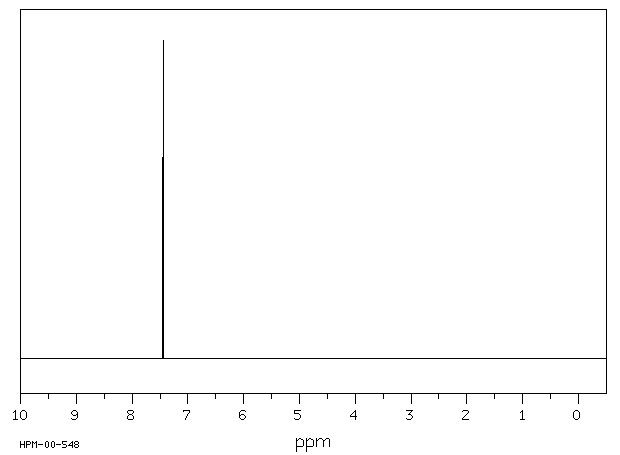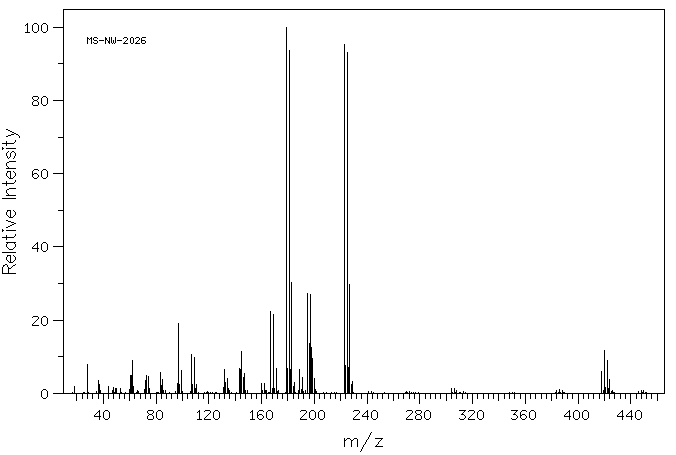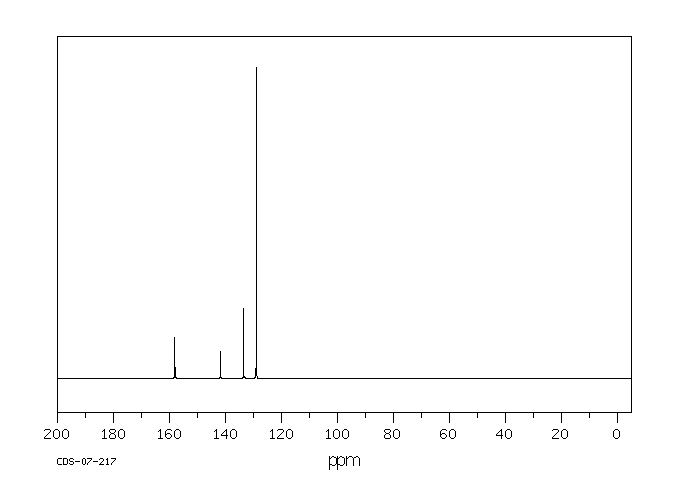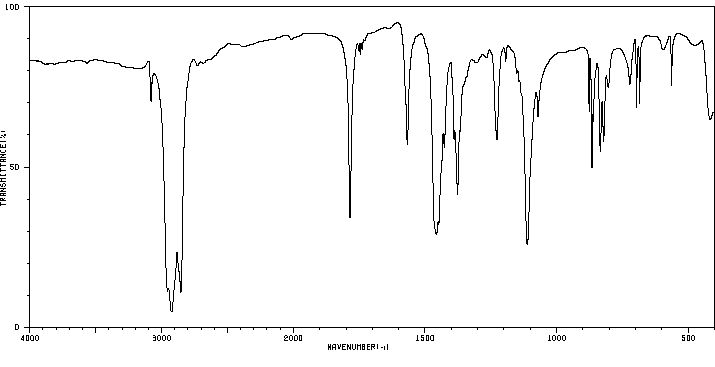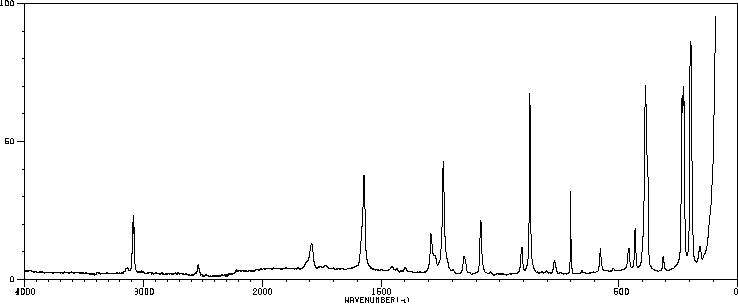双(2,4,6-三氯苯基)草酸酯 | 1165-91-9
中文名称
双(2,4,6-三氯苯基)草酸酯
中文别名
草酸双(2,4,6-三氯苯)酯;双三氯苯基草酸酯
英文名称
bis(2,4,6-trichlorophenyl) oxalate
英文别名
TCPO;Bis-(2,4,6-trichlorphenyl)-oxalat
CAS
1165-91-9
化学式
C14H4Cl6O4
mdl
MFCD00043061
分子量
448.901
InChiKey
GEVPIWPYWJZSPR-UHFFFAOYSA-N
BEILSTEIN
——
EINECS
——
-
物化性质
-
计算性质
-
ADMET
-
安全信息
-
SDS
-
制备方法与用途
-
上下游信息
-
文献信息
-
表征谱图
-
同类化合物
-
相关功能分类
-
相关结构分类
物化性质
-
熔点:188-192 °C
-
沸点:556.17°C (rough estimate)
-
密度:1.698
-
闪点:188-192°C
-
溶解度:在热甲苯中几乎完全溶解
-
稳定性/保质期:
如果按照规定使用和储存,则不会分解,没有已知的危险反应,应避免与氧化物接触。
计算性质
-
辛醇/水分配系数(LogP):7.3
-
重原子数:24
-
可旋转键数:5
-
环数:2.0
-
sp3杂化的碳原子比例:0.0
-
拓扑面积:52.6
-
氢给体数:0
-
氢受体数:4
安全信息
-
危险品标志:Xi
-
安全说明:S26,S36,S36/37/39
-
危险类别码:R21/22,R36/37/38
-
WGK Germany:3
-
海关编码:2917119000
-
危险品运输编号:HAZARD
-
危险标志:GHS07
-
危险性描述:H315,H319,H335
-
危险性防范说明:P261,P305 + P351 + P338
-
包装等级:III
-
危险类别:9
-
储存条件:密封存储,并在-18°C下保存。
SDS
双(2,4,6-三氯苯基)草酸酯[用于荧光性化合物测定的化学 修改号码:5
发光试剂]
模块 1. 化学品
产品名称: Bis(2,4,6-trichlorophenyl) Oxalate [Chemiluminescence reageNT for the
determination of fluoresceNT compounds]
修改号码: 5
模块 2. 危险性概述
GHS分类
物理性危害 未分类
健康危害 未分类
环境危害 未分类
GHS标签元素
图标或危害标志 无
信号词 无信号词
危险描述 无
防范说明 无
模块 3. 成分/组成信息
单一物质/混和物 单一物质
化学名(中文名): 双(2,4,6-三氯苯基)草酸酯[用于荧光性化合物测定的化学发光试剂]
百分比: >98.0%(T)
CAS编码: 1165-91-9
俗名: Oxalic Acid Bis(2,4,6-trichlorophenyl) Ester , TCPO
分子式: C14H4Cl6O4
模块 4. 急救措施
吸入: 将受害者移到新鲜空气处,保持呼吸通畅,休息。若感不适请求医/就诊。
皮肤接触: 立即去除/脱掉所有被污染的衣物。用水清洗皮肤/淋浴。
若皮肤刺激或发生皮疹:求医/就诊。
眼睛接触: 用水小心清洗几分钟。如果方便,易操作,摘除隐形眼镜。继续清洗。
如果眼睛刺激:求医/就诊。
食入: 若感不适,求医/就诊。漱口。
紧急救助者的防护: 救援者需要穿戴个人防护用品,比如橡胶手套和气密性护目镜。
修改号码:5
定的化学发光试剂]
模块 5. 消防措施
合适的灭火剂: 干粉,泡沫,雾状水,二氧化碳
特殊危险性: 小心,燃烧或高温下可能分解产生毒烟。
特定方法: 从上风处灭火,根据周围环境选择合适的灭火方法。
非相关人员应该撤离至安全地方。
周围一旦着火:如果安全,移去可移动容器。
消防员的特殊防护用具: 灭火时,一定要穿戴个人防护用品。
模块 6. 泄漏应急处理
个人防护措施,防护用具, 使用个人防护用品。远离溢出物/泄露处并处在上风处。
紧急措施: 泄露区应该用安全带等圈起来,控制非相关人员进入。
环保措施: 防止进入下水道。
控制和清洗的方法和材料: 清扫收集粉尘,封入密闭容器。注意切勿分散。附着物或收集物应该立即根据合适的
法律法规处置。
模块 7. 操作处置与储存
处理
技术措施: 在通风良好处进行处理。穿戴合适的防护用具。防止粉尘扩散。处理后彻底清洗双手
和脸。
注意事项: 如果粉尘或浮质产生,使用局部排气。
操作处置注意事项: 避免接触皮肤、眼睛和衣物。
贮存
储存条件: 保持容器密闭。存放于凉爽、阴暗处。
存放于惰性气体环境中。
防湿。
远离不相容的材料比如氧化剂存放。
潮敏
包装材料: 依据法律。
模块 8. 接触控制和个体防护
工程控制: 尽可能安装封闭体系或局部排风系统,操作人员切勿直接接触。同时安装淋浴器和洗
眼器。
个人防护用品
呼吸系统防护: 防尘面具。依据当地和政府法规。
手部防护: 防护手套。
眼睛防护: 安全防护镜。如果情况需要,佩戴面具。
皮肤和身体防护: 防护服。如果情况需要,穿戴防护靴。
模块 9. 理化特性
外形(20°C): 固体
外观: 晶体-粉末
颜色: 白色类白色
气味: 无资料
pH: 无数据资料
熔点:
190°C
沸点/沸程 无资料
闪点: 无资料
爆炸特性
爆炸下限: 无资料
爆炸上限: 无资料
修改号码:5
定的化学发光试剂]
模块 9. 理化特性
密度: 无资料
溶解度:
[水] 无资料
[其他溶剂] 无资料
模块 10. 稳定性和反应性
化学稳定性: 一般情况下稳定。
危险反应的可能性: 未报道特殊反应性。
须避免接触的物质 氧化剂
危险的分解产物: 一氧化碳, 二氧化碳, 氯化氢
模块 11. 毒理学信息
急性毒性: 无资料
对皮肤腐蚀或刺激: 无资料
对眼睛严重损害或刺激: 无资料
生殖细胞变异原性: 无资料
致癌性:
IARC = 无资料
NTP = 无资料
生殖毒性: 无资料
模块 12. 生态学信息
生态毒性:
鱼类: 无资料
甲壳类: 无资料
藻类: 无资料
残留性 / 降解性: 无资料
潜在生物累积 (BCF): 无资料
土壤中移动性
log水分配系数: 无资料
土壤吸收系数 (Koc): 无资料
亨利定律 无资料
constaNT(PaM3/mol):
模块 13. 废弃处置
如果可能,回收处理。请咨询当地管理部门。建议在可燃溶剂中溶解混合,在装有后燃和洗涤装置的化学焚烧炉中
焚烧。废弃处置时请遵守国家、地区和当地的所有法规。
模块 14. 运输信息
联合国分类: 与联合国分类标准不一致
UN编号: 未列明
模块 15. 法规信息
《危险化学品安全管理条例》(2002年1月26日国务院发布,2011年2月16日修订): 针对危险化学品的安全使用、
生产、储存、运输、装卸等方面均作了相应的规定。
修改号码:5
定的化学发光试剂]
模块16 - 其他信息
N/A
发光试剂]
模块 1. 化学品
产品名称: Bis(2,4,6-trichlorophenyl) Oxalate [Chemiluminescence reageNT for the
determination of fluoresceNT compounds]
修改号码: 5
模块 2. 危险性概述
GHS分类
物理性危害 未分类
健康危害 未分类
环境危害 未分类
GHS标签元素
图标或危害标志 无
信号词 无信号词
危险描述 无
防范说明 无
模块 3. 成分/组成信息
单一物质/混和物 单一物质
化学名(中文名): 双(2,4,6-三氯苯基)草酸酯[用于荧光性化合物测定的化学发光试剂]
百分比: >98.0%(T)
CAS编码: 1165-91-9
俗名: Oxalic Acid Bis(2,4,6-trichlorophenyl) Ester , TCPO
分子式: C14H4Cl6O4
模块 4. 急救措施
吸入: 将受害者移到新鲜空气处,保持呼吸通畅,休息。若感不适请求医/就诊。
皮肤接触: 立即去除/脱掉所有被污染的衣物。用水清洗皮肤/淋浴。
若皮肤刺激或发生皮疹:求医/就诊。
眼睛接触: 用水小心清洗几分钟。如果方便,易操作,摘除隐形眼镜。继续清洗。
如果眼睛刺激:求医/就诊。
食入: 若感不适,求医/就诊。漱口。
紧急救助者的防护: 救援者需要穿戴个人防护用品,比如橡胶手套和气密性护目镜。
修改号码:5
定的化学发光试剂]
模块 5. 消防措施
合适的灭火剂: 干粉,泡沫,雾状水,二氧化碳
特殊危险性: 小心,燃烧或高温下可能分解产生毒烟。
特定方法: 从上风处灭火,根据周围环境选择合适的灭火方法。
非相关人员应该撤离至安全地方。
周围一旦着火:如果安全,移去可移动容器。
消防员的特殊防护用具: 灭火时,一定要穿戴个人防护用品。
模块 6. 泄漏应急处理
个人防护措施,防护用具, 使用个人防护用品。远离溢出物/泄露处并处在上风处。
紧急措施: 泄露区应该用安全带等圈起来,控制非相关人员进入。
环保措施: 防止进入下水道。
控制和清洗的方法和材料: 清扫收集粉尘,封入密闭容器。注意切勿分散。附着物或收集物应该立即根据合适的
法律法规处置。
模块 7. 操作处置与储存
处理
技术措施: 在通风良好处进行处理。穿戴合适的防护用具。防止粉尘扩散。处理后彻底清洗双手
和脸。
注意事项: 如果粉尘或浮质产生,使用局部排气。
操作处置注意事项: 避免接触皮肤、眼睛和衣物。
贮存
储存条件: 保持容器密闭。存放于凉爽、阴暗处。
存放于惰性气体环境中。
防湿。
远离不相容的材料比如氧化剂存放。
潮敏
包装材料: 依据法律。
模块 8. 接触控制和个体防护
工程控制: 尽可能安装封闭体系或局部排风系统,操作人员切勿直接接触。同时安装淋浴器和洗
眼器。
个人防护用品
呼吸系统防护: 防尘面具。依据当地和政府法规。
手部防护: 防护手套。
眼睛防护: 安全防护镜。如果情况需要,佩戴面具。
皮肤和身体防护: 防护服。如果情况需要,穿戴防护靴。
模块 9. 理化特性
外形(20°C): 固体
外观: 晶体-粉末
颜色: 白色类白色
气味: 无资料
pH: 无数据资料
熔点:
190°C
沸点/沸程 无资料
闪点: 无资料
爆炸特性
爆炸下限: 无资料
爆炸上限: 无资料
修改号码:5
定的化学发光试剂]
模块 9. 理化特性
密度: 无资料
溶解度:
[水] 无资料
[其他溶剂] 无资料
模块 10. 稳定性和反应性
化学稳定性: 一般情况下稳定。
危险反应的可能性: 未报道特殊反应性。
须避免接触的物质 氧化剂
危险的分解产物: 一氧化碳, 二氧化碳, 氯化氢
模块 11. 毒理学信息
急性毒性: 无资料
对皮肤腐蚀或刺激: 无资料
对眼睛严重损害或刺激: 无资料
生殖细胞变异原性: 无资料
致癌性:
IARC = 无资料
NTP = 无资料
生殖毒性: 无资料
模块 12. 生态学信息
生态毒性:
鱼类: 无资料
甲壳类: 无资料
藻类: 无资料
残留性 / 降解性: 无资料
潜在生物累积 (BCF): 无资料
土壤中移动性
log水分配系数: 无资料
土壤吸收系数 (Koc): 无资料
亨利定律 无资料
constaNT(PaM3/mol):
模块 13. 废弃处置
如果可能,回收处理。请咨询当地管理部门。建议在可燃溶剂中溶解混合,在装有后燃和洗涤装置的化学焚烧炉中
焚烧。废弃处置时请遵守国家、地区和当地的所有法规。
模块 14. 运输信息
联合国分类: 与联合国分类标准不一致
UN编号: 未列明
模块 15. 法规信息
《危险化学品安全管理条例》(2002年1月26日国务院发布,2011年2月16日修订): 针对危险化学品的安全使用、
生产、储存、运输、装卸等方面均作了相应的规定。
修改号码:5
定的化学发光试剂]
模块16 - 其他信息
N/A
制备方法与用途
用途:用于测定荧光性化合物的化学发光试剂
反应信息
-
作为反应物:描述:参考文献:名称:Light Emission of Gold Nanoparticles Induced by the Reaction of Bis(2,4,6-trichlorophenyl) Oxalate and Hydrogen Peroxide摘要:在含有双(2,4,6-三氯苯基)草酸酯和过氧化氢的溶液中分散直径为 2.6-6.0 nm 的金颗粒,观察到其在 ∼415 nm 处发光。结果发现,光强与大小相近的金纳米粒子的保护试剂无关,直径为 5.0 和 6.0 nm 的金纳米粒子的光强强于直径为 2.6 和 2.8 nm 的金纳米粒子,使用 6.0 nm 的金纳米粒子时,光强随金纳米粒子的浓度呈线性增长。经鉴定,金纳米粒子是发光物种,使用 6.0 纳米金粒子时,量子产率为 (2.8 ± 0.3) × 10-5。发光过程涉及一系列步骤:草酸二(2,4,6-三氯苯基)酯与过氧化氢发生氧化反应,生成富含能量的中间体 1,2-二氧杂环丁二酮;能量从中间体转移到金纳米粒子;以及形成的放电状态金纳米粒子发生辐射弛豫。由于金纳米粒子具有良好的生物相容性和相对较高的稳定性,因此观察到的发光现象有望应用于生物分析领域。DOI:10.1021/ac050882q
-
作为产物:描述:参考文献:名称:草酸芳基酯衍生物作为生成芳氧基自由基的方便前体。摘要:描述了在溶液和刚性基质条件下使用芳氧基草酰氯(AOC),芳氧基草酰叔丁基过氧化物(AOB)和草酸二芳基酯(DAO)来单分子生成苯氧基基团的现象。AOC可用于光化学生成苯氧基自由基,但仅当使用2,6-二叔丁基化衍生物时,才能方便地稳定用作前体。AOB可用作芳氧基的热前体,因为它们通常会在60-85摄氏度下2-3小时内分解以产生酚。(1)H-NMR溶液动力学研究发现,对于苯氧基草酰叔丁基过氧化物的分解,DeltaH()= 31 kcal / mol,DeltaS()= +3.4 cal / mol-K,这与过氧化物键断裂的基本一致一致。AOB和更稳定的DAO也是方便的光化学苯氧基自由基前体。DOI:10.1021/jo951696v
文献信息
-
Study of the characteristics of three high-energy intermediates generated in peroxyoxalate chemiluminescence (PO-CL) reactions作者:Ji Hoon Lee、James C. Rock、Seung Bum Park、Mark A. Schlautman、Elizabeth R. CarrawayDOI:10.1039/b109210c日期:2002.3.25Perylene emission intensity generated from peroxyoxalate chemiluminescence (PO-CL) reactions was studied as a function of time and order of reagent addition. Based on 1H-NMR analyses, kinetics of UV absorbance and emission intensity vs. time profiles, we conclude that PO-CL reactions in the presence of imidazole (ImH) can proceed by three distinct reaction pathways depending on how the reagents are mixed together. When bis(2,4,6-trichlorophenyl) oxalate (TCPO) is mixed simultaneously with H2O2, ImH and perylene, a slowly decaying emission curve is generated from the interaction between perylene and a high-energy intermediate (i.e., six- or eight-membered cyclic compound) formed by the ImH-catalyzed nucleophilic reaction (TCPO-CL reaction). Upon mixing TCPO simultaneously with ImH and perylene in the absence of H2O2, however, distinctly different CL curves of lower intensity are generated from the interaction between perylene and a new, unknown high-energy intermediate formed from the reaction between the aryl oxalate and ImH. Finally, using 1H-NMR, we observed that 1,1′-oxalyldiimidazole (ODI) is also formed from the reaction between TCPO and ImH. When ODI reacts with excess H2O2 in the presence of perylene, a higher intensity and relatively fast decaying emission curve is generated (ODI-CL reaction) from the interaction between perylene and the high-energy intermediate produced, which we propose is imidazolylhydroxydioxetanone or 1,2-dioxetanedione.研究了过氧草酸酯化学发光(PO-CL)反应中生成的苝的发光强度随时间和试剂添加顺序的变化。根据1H-NMR分析、UV吸收和发光强度随时间的动力学曲线,我们得出结论:在存在咪唑(ImH)的情况下,PO-CL反应可以通过三种不同的反应途径进行,这取决于试剂是如何混合在一起的。当双(2,4,6-三氯苯基)草酸酯(TCPO)与H2O2、ImH和苝同时混合时,会产生一条缓慢衰减的发光曲线,这是由于苝与ImH催化的亲核反应(TCPO-CL反应)形成的高能中间体(即六元或八元环状化合物)相互作用的结果。然而,在没有 的情况下,将TCPO与ImH和苝同时混合时,会产生一个强度较低且截然不同的化学发光曲线,这是由于苝与由芳基草酸酯和ImH反应形成的新型未知高能中间体相互作用的结果。最后,利用1H-NMR,我们观察到1,1'-草酰二咪唑(ODI)也是从TCPO和ImH反应中形成的。当ODI在苝存在下与过量的 反应时,产生一个强度较高且相对快速衰减的发光曲线(ODI-CL反应),我们推测这是由于苝与形成的高能中间体(可能是咪唑基羟基二氧杂环丁酮或1,2-二氧杂环丁二酮)相互作用的结果。
-
Kinetics and Mechanism of the Nucleophilic Substitution Reaction of Imidazole with Bis(2,4,6-trichlorophenyl) Oxalate and Bis(2,4-dinitrophenyl) Oxalate作者:Andrew G. Hadd、John W. BirksDOI:10.1021/jo951627g日期:1996.1.1wavelength range for TCPO and at 420 nm for DNPO. The reaction proceeds by release of two molecules of substituted phenol and formation of 1,1'-oxalyldiimidazole (ODI) for both esters. The identity of ODI was confirmed in the reaction of imidazole with TCPO by its UV absorbance spectrum and (13)C-NMR spectrum. The reaction of imidazole with TCPO has a second-order dependence on imidazole concentration and通过停止流动技术研究了咪唑催化的草酸双(2,4,6-三氯苯基)(TCPO)和草酸双(2,4-二硝基苯基)(DNPO)的分解动力学。通过拟合TCPO在整个245至345 nm波长范围内的吸光度随时间变化以及DNPO在420 nm处的吸光度随时间变化,将伪一级速率常数确定为6-45℃温度范围内咪唑浓度的函数。通过释放两个取代的苯酚分子并形成两种酯的1,1'-草酰二咪唑(ODI)来进行反应。通过咪唑的UV吸收光谱和(13)C-NMR光谱证实了咪唑与TCPO的反应中ODI的身份。咪唑与TCPO的反应对咪唑浓度具有二阶依赖性,并且观察到的负活化能为-6.2 +/- 0。3 kJ / mol,而DNPO反应对咪唑浓度具有一级依赖性,观察到的正活化能为12.0 +/- 0.6 kJ / mol。对于两种草酸酯而言,温度依赖性和反应相对于咪唑的反应顺序的差异可以通过速率确定步骤的变化来解释,该步骤从向DN
-
New Nucleophilic Catalysts for Bright and Fast Peroxyoxalate Chemiluminescence作者:Tobias Jonsson、Knut IrgumDOI:10.1021/ac991339a日期:2000.4.1the production of the highly nucleophilic 1,2,4-triazolate anion, which as the actual catalyst then participated in the formation of a more reactive transient reagent. All the investigated catalysts reduced the light yield of the reaction due to base-catalyzed breakdown reactions of the reagents and/or intermediates. The intensity peak maximums of these bright and fast reactions typically appeared after基于化学发光的小型化检测应用需要快速的反应动力学才能实现最佳性能。在这项工作中,通过同时使用单组分和双组分亲核催化,以高速率产生了可用于分析的过氧草酸酯化学发光反应的高强度光。4-(二甲胺)吡啶及其衍生物在反应速度和所产生的光的强度上均优于所有其他碱,并且迄今被认为是最好的咪唑。光强度与4-氨基吡啶催化剂和试剂离去基团之间的pKa差异有关,并且发现最佳ΔpKa接近于0。类似地,当咪唑类似物的混合物时,可获得高光强度。 1,2,4-三唑和强的非亲核碱1,2,2,6,6-五甲基哌啶用作催化剂。结论是,这种机理是“碱诱导的亲核催化”,其中辅助的强碱辅助了高度亲核的1,2,4-三唑酸根阴离子的产生,该阴离子作为实际的催化剂随后参与了a的形成。反应性更高的瞬态试剂。由于催化剂和/或中间体的碱催化分解反应,所有研究的催化剂均降低了反应的光产率。这些明亮而快速的反应的强度峰值最大值通常在不到10毫秒后出现,然后光在几秒钟内衰减为黑暗。
-
Mechanistic Studies on the Salicylate‐Catalyzed Peroxyoxalate Chemiluminescence in Aqueous Medium作者:Maidileyvis C. Cabello、Glalci A. Souza、Liena V. Bello、Wilhelm J. BaaderDOI:10.1111/php.13180日期:2020.1mixture with bis(2,4,6‐trichlorophenyl) oxalate (TCPO), bis(4‐methylphenyl) oxalate (BMePO) and bis[2‐(methoxycarbonyl)phenyl] oxalate (DMO), catalyzed by sodium salicylate, in the presence of rhodamine 6G as activator. Reproducible kinetic results are obtained for all systems; emission decay rate constants depend on the salicylate as well as hydrogen peroxide concentration, and the occurrence of a过氧草酸盐反应是已知的最有效的化学发光转化之一,也是唯一通过分子间化学引发的电子交换发光 (CIEEL) 机制发生的系统,并具有已证实的高量子产率。过氧草酸盐化学发光(PO-CL)主要在无水有机介质中进行研究;然而,对于生物分析应用,它应该在水性介质中进行。在目前的工作中,我们研究了二元 1,2-二甲氧基乙烷/水混合物中的过氧草酸盐体系,其中含有双(2,4,6-三氯苯基)草酸盐(TCPO)、双(4-甲基苯基)草酸盐(BMePO)和双[ 2-(甲氧基羰基)苯基]草酸盐(DMO),由水杨酸钠催化,在罗丹明6G作为活化剂的存在下。所有系统均可获得可重现的动力学结果;排放衰减率常数取决于水杨酸盐和过氧化氢浓度,并验证了特定碱催化的发生。尽管在类似条件下测定的单线态量子产率低于无水介质,但它们仍然相当高,足以用于分析应用。“生态友好”衍生物 DMO 获得了最高的单线态量子产率,表明该衍生物可能是过氧
-
Novel chemiluminescent detection of chemical warfare simulant作者:Himali S. Hewage、Karl J. Wallace、Eric V. AnslynDOI:10.1039/b706624d日期:——A glow assay technology for the detection of a chemical warfare simulant is presented, which is based on modulating the peroxyoxalate chemiluminescence pathway by way of utilising an oximate super nucleophile that gives an “off–on” glow response.
表征谱图
-
氢谱1HNMR
-
质谱MS
-
碳谱13CNMR
-
红外IR
-
拉曼Raman
-
峰位数据
-
峰位匹配
-
表征信息
同类化合物
(βS)-β-氨基-4-(4-羟基苯氧基)-3,5-二碘苯甲丙醇
(S,S)-邻甲苯基-DIPAMP
(S)-(-)-7'-〔4(S)-(苄基)恶唑-2-基]-7-二(3,5-二-叔丁基苯基)膦基-2,2',3,3'-四氢-1,1-螺二氢茚
(S)-盐酸沙丁胺醇
(S)-3-(叔丁基)-4-(2,6-二甲氧基苯基)-2,3-二氢苯并[d][1,3]氧磷杂环戊二烯
(S)-2,2'-双[双(3,5-三氟甲基苯基)膦基]-4,4',6,6'-四甲氧基联苯
(S)-1-[3,5-双(三氟甲基)苯基]-3-[1-(二甲基氨基)-3-甲基丁烷-2-基]硫脲
(R)富马酸托特罗定
(R)-(-)-盐酸尼古地平
(R)-(-)-4,12-双(二苯基膦基)[2.2]对环芳烷(1,5环辛二烯)铑(I)四氟硼酸盐
(R)-(+)-7-双(3,5-二叔丁基苯基)膦基7''-[((6-甲基吡啶-2-基甲基)氨基]-2,2'',3,3''-四氢-1,1''-螺双茚满
(R)-(+)-7-双(3,5-二叔丁基苯基)膦基7''-[(4-叔丁基吡啶-2-基甲基)氨基]-2,2'',3,3''-四氢-1,1''-螺双茚满
(R)-(+)-7-双(3,5-二叔丁基苯基)膦基7''-[(3-甲基吡啶-2-基甲基)氨基]-2,2'',3,3''-四氢-1,1''-螺双茚满
(R)-(+)-4,7-双(3,5-二-叔丁基苯基)膦基-7“-[(吡啶-2-基甲基)氨基]-2,2”,3,3'-四氢1,1'-螺二茚满
(R)-3-(叔丁基)-4-(2,6-二苯氧基苯基)-2,3-二氢苯并[d][1,3]氧杂磷杂环戊烯
(R)-2-[((二苯基膦基)甲基]吡咯烷
(R)-1-[3,5-双(三氟甲基)苯基]-3-[1-(二甲基氨基)-3-甲基丁烷-2-基]硫脲
(N-(4-甲氧基苯基)-N-甲基-3-(1-哌啶基)丙-2-烯酰胺)
(5-溴-2-羟基苯基)-4-氯苯甲酮
(5-溴-2-氯苯基)(4-羟基苯基)甲酮
(5-氧代-3-苯基-2,5-二氢-1,2,3,4-oxatriazol-3-鎓)
(4S,5R)-4-甲基-5-苯基-1,2,3-氧代噻唑烷-2,2-二氧化物-3-羧酸叔丁酯
(4S,4''S)-2,2''-亚环戊基双[4,5-二氢-4-(苯甲基)恶唑]
(4-溴苯基)-[2-氟-4-[6-[甲基(丙-2-烯基)氨基]己氧基]苯基]甲酮
(4-丁氧基苯甲基)三苯基溴化磷
(3aR,8aR)-(-)-4,4,8,8-四(3,5-二甲基苯基)四氢-2,2-二甲基-6-苯基-1,3-二氧戊环[4,5-e]二恶唑磷
(3aR,6aS)-5-氧代六氢环戊基[c]吡咯-2(1H)-羧酸酯
(2Z)-3-[[(4-氯苯基)氨基]-2-氰基丙烯酸乙酯
(2S,3S,5S)-5-(叔丁氧基甲酰氨基)-2-(N-5-噻唑基-甲氧羰基)氨基-1,6-二苯基-3-羟基己烷
(2S,2''S,3S,3''S)-3,3''-二叔丁基-4,4''-双(2,6-二甲氧基苯基)-2,2'',3,3''-四氢-2,2''-联苯并[d][1,3]氧杂磷杂戊环
(2S)-(-)-2-{[[[[3,5-双(氟代甲基)苯基]氨基]硫代甲基]氨基}-N-(二苯基甲基)-N,3,3-三甲基丁酰胺
(2S)-2-[[[[[((1S,2S)-2-氨基环己基]氨基]硫代甲基]氨基]-N-(二苯甲基)-N,3,3-三甲基丁酰胺
(2S)-2-[[[[[[((1R,2R)-2-氨基环己基]氨基]硫代甲基]氨基]-N-(二苯甲基)-N,3,3-三甲基丁酰胺
(2-硝基苯基)磷酸三酰胺
(2,6-二氯苯基)乙酰氯
(2,3-二甲氧基-5-甲基苯基)硼酸
(1S,2S,3S,5S)-5-叠氮基-3-(苯基甲氧基)-2-[(苯基甲氧基)甲基]环戊醇
(1S,2S,3R,5R)-2-(苄氧基)甲基-6-氧杂双环[3.1.0]己-3-醇
(1-(4-氟苯基)环丙基)甲胺盐酸盐
(1-(3-溴苯基)环丁基)甲胺盐酸盐
(1-(2-氯苯基)环丁基)甲胺盐酸盐
(1-(2-氟苯基)环丙基)甲胺盐酸盐
(1-(2,6-二氟苯基)环丙基)甲胺盐酸盐
(-)-去甲基西布曲明
龙蒿油
龙胆酸钠
龙胆酸叔丁酯
龙胆酸
龙胆紫-d6
龙胆紫


